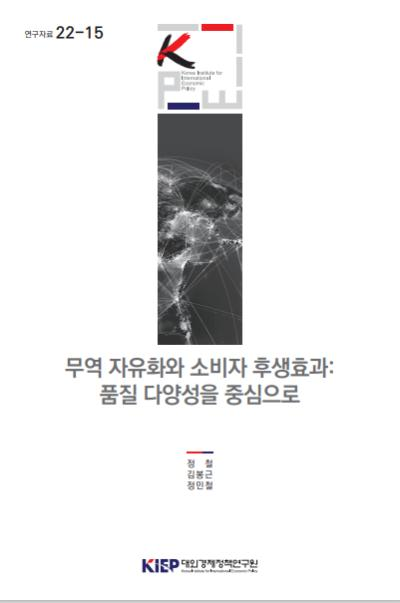Policy Reference
PUBLISH
Policy Reference
To list

The Impact of Trade Liberalization on Consumer Welfare: A Focus on Quality Diversity
Trade policy, Free trade
Author Chul Chung, Bonggeun Kim, and Minchirl Chung Series 22-15 Language Korean Date 2023.05.25
This study investigates the impact of domestic price changes due to external shocks such as trade liberalization or global inflation on quality diversity and consumer welfare. Free trade agreements (FTAs) can reduce the prices of imported goods through tariff elimination or reduction, making it crucial to evaluate academically and in terms of policy how this price reduction affects consumer welfare. In contrast to prior literature on trade liberalization, this study emphasizes the role of quality diversity in explaining its impact on consumer welfare. We focus on how consumers’ qualitative responses to price changes, such as selecting high-quality products when prices decrease due to tariff reductions or responding to price increases due to tobacco taxes by adjusting the quality of their purchases, can influence consumer welfare. This study also provides policy implications regarding the impact of trade liberalization on consumer welfare.
Using time-series data on wine and cigarettes in South Korea, this research estimated price elasticities and separated them into consumers’ quantitative and qualitative responses to price changes. The results indicate that the qualitative margin accounts for as much as 40% of the total, demonstrating that consumers’ qualitative responses to price changes are quite significant. We also found a statistically significant consumer behavior mechanism of quality shading in response to price increases for both wine and cigarette consumption, suggesting that consumers’ qualitative responses are as important as their quantitative responses. Moreover, we found that price reductions not only increase the consumption quantity of the same product but also lead to a shift to higher quality products, further enhancing consumers’ welfare. For the first time in the literature, we analyzed qualitative margins by income level and found that the price elasticity is higher for lower-income consumers, and most of it can be attributed to qualitative responses. These empirical findings suggest that consumers can adjust their spending on a particular good through qualitative adjustments while maintaining their overall consumption, particularly in response to rapid inflation. This response mechanism is particularly more effective for low-income households.
Similarly, this study confirmed the existence of consumer quality adjustment responses to income changes through income elasticity analysis, with the size being larger among low-income households. Qualitative responses to income changes demonstrate that consumers can adjust their expenditure by maintaining the consumption level of staple goods such as rice or pork while reducing the expenditure amount, particularly in situations of declining real income during economic crisis. As with the analysis of price changes, our results suggest that this consumer behavioral mechanism in response to income changes can be also more effective for low-income households.
The findings of this study indicate that trade liberalization’s expansion of quality diversity has a positive impact on consumer welfare by strengthening consumer mechanisms, particularly in response to inflation, drastic price changes, and real income declines during economic crises. These results provide a novel perspective on trade liberalization’s contribution to consumer welfare, with the analyzed quality diversity effect distinct from the product diversity described in traditional trade literature, thus representing a new source of gains from trade. Consequently, when assessing trade liberalization’s economic impacts, the quality diversity factor should also be considered. In addition, this study demonstrated that quality diversity expansion for consumers can be achieved for agricultural products through not only agricultural production policies but also trade liberalization. The resulting policy implications are significant for both average consumers and low-income groups in terms of welfare.
However, the qualitative response of consumers to price changes may not always improve policy efficacy, particularly for certain types of goods, such as harmful goods taxes, where product quality diversity may not necessarily have a positive impact and can even have a negative one. For instance, if consumers switch to low-quality cigarettes in response to an increase in cigarette taxes, the quality-downgrading response may ultimately have adverse effects on health indicators related to cigarette taxes. Furthermore, when discussing harmful goods taxes, such as soda taxes and fast-food taxes, to combat obesity problems, the expansion of quality diversity can have the opposite effect, increasing the supply of unhealthy low-quality carbonated drinks or fast food. These discussions hold significant policy implications, indicating that to achieve health policy objectives through harmful goods taxes, it is necessary to prevent low-quality goods from entering the market, which could pose greater health risks. Finally, empirical research follow-up is needed for staple goods such as rice or pork, with future studies needing to consider consumers’ qualitative responses when using price elasticity.
Sales Info
| Quantity/Size | 111 |
|---|---|
| Sale Price | 7 $ |
 공공저작물 자유이용허락 표시기준 (공공누리, KOGL) 제4유형
공공저작물 자유이용허락 표시기준 (공공누리, KOGL) 제4유형
대외경제정책연구원의 본 공공저작물은 "공공누리 제4유형 : 출처표시 + 상업적 금지 + 변경금지” 조건에 따라 이용할 수 있습니다. 저작권정책 참조
